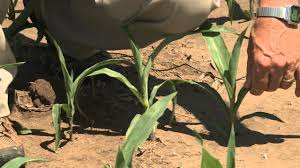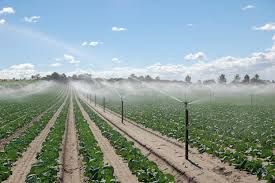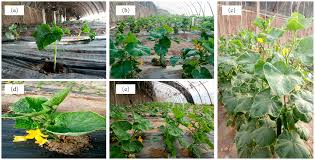Crops require water for their physiological processes, and when water is in short supply, it causes water stress, leading to wilting, reduced growth, development, and yield.
There are certain stages in the growth of a plant where it can withstand water stress, and others where the lack of water drastically reduces yield.
These stages are referred to as the critical growth stages of a crop or plant. This article discusses the critical water requirements for different crops at various growth stages.
Read Also: How to Grow, Use and Care for Whitetinge Sedge Grass (Carex albicans)
Critical Growth Stages for Water in Different Crops

The critical growth stage of a crop for water is the point in its growth when water is critically needed to prevent crop loss or reduced yield.
During this stage, adequate water must be supplied to maximize water use efficiency, increasing or maintaining the crop’s yield potential.
Different crops have different critical growth stages depending on their type of yield.
The critical growth stages of some crops are listed below:
| S/N | Crop | Growth Period Sensitive to Water Stress | Growth Interval in Which Irrigation Produces Greatest Benefits |
|---|---|---|---|
| 1. | Sorghum | Boot heading | Boot to soft dough stage |
| 2. | Wheat | Boot flowering | Jointing to soft dough |
| 3. | Maize | Tassel-pollination | 12-leaf to blister kernel |
| 4. | Cotton | At first bloom – peak bloom | First bloom to bolls well-formed |
| 5. | Bean | Flowering – early pod fill | Axillary bud – pod fill |
| 6. | Potatoes | Tuberization | Tuberization to maturity |
| 7. | Soybean | Flowering – early pod fill | Axillary bud – pod fill |
| 8. | Sugarcane | No critical stage | None |
| 9. | Onions | Bulb formation | None |
| 10. | Tomatoes | After fruit set | None |
| 11. | Fruit Trees | Any point during growing season | None |
Stages of Growth Affected by Irrigation Practices
The stages of plant growth affected by irrigation can be divided into three key phases:
i. Vegetative stage
ii. Flowering stage
iii. Fruiting stage
The relationship between these stages of growth and consumptive use (water use for growth and development) is illustrated in the figure below.
Generalized Curve Comparing Consumptive-Evaporation Ratio to Relative Growth of Crop
Soil types should also be considered in irrigation scheduling. Sandy soils require more frequent watering (2 times/day) compared to clay soils, which require irrigation once every 2–3 days.
During the vegetative stage, consumptive use continues to increase. Flowering occurs near the peak of consumptive use. In the fruiting stage, consumptive use decreases until transpiration essentially ceases in the later part of fruit formation.
The fruiting stage can be divided into two parts: the wet fruit stage, following flowering, and the dry fruit stage, following wet fruit growth. Dry fruit is accompanied by a decrease in consumptive use until transpiration ceases and the plant dies.
The amount of water applied and the frequency of irrigation must be adjusted according to the crop’s actual consumptive use, the water-holding capacity of the soil, and the depth of rooting. Naturally, shallow sandy soils will require different irrigation schedules than deep clay loam soils.
Read Also: How to Grow, Use and Care for Whitegrass (Leersia virginica)
Irrigation During the Vegetative Stage of Growth

A sufficient moisture supply is essential for plants throughout the vegetative growth stage. Nitrogen is particularly important during this stage. Light, frequent irrigation is generally preferred to maintain adequate moisture in the soil, especially for crops with relatively shallow root systems.
For perennial crops with deeper root systems, less frequent but heavier irrigation is necessary. In areas with excessive temperatures, frequent irrigation may be needed to cool the soil and plant.
Irrigation During the Flowering Stage of Growth
Since consumptive use is at its peak during the flowering stage, it is crucial to ensure adequate moisture in the root zone. However, the increased consumptive use is counteracted by the normal increase in root depth.
Deeper roots provide a greater root zone depth, resulting in a greater available water supply. When considering the increased root depth, the frequency of irrigation remains relatively constant during the vegetative and flowering periods.
Optimal production is achieved if the crop is kept adequately irrigated throughout both the vegetative and flowering periods.
Irrigation During the Fruiting Stage of Growth

By the time fruiting occurs, the root system has extended to its maximum depth, and consumptive use begins to decrease, reducing the crop’s water requirements and the frequency of irrigation.
During dry fruit production, irrigation essentially ceases. Any slight water requirements are met by the stored water in the soil. The last heavy irrigation should typically occur during the wet fruit stage, ensuring that the deep roots have access to water during the final stages of fruit development.
Tubers, such as potatoes and peanuts, require adequate moisture throughout the entire growth period. Allowing the soil to dry between irrigations results in uneven tuber growth.
Ample aeration is also essential, which is why good-quality potatoes are typically grown in sandy loam soils that allow for frequent irrigation without problems. However, clay soils increase resistance to growing tubers, restricting growth and resulting in non-uniform tubers.
Sufficient moisture is necessary to fully develop wet fruits. For example, soft fleshy fruits, green peas, and grains will not be firm and fully formed unless adequate moisture is available.
Excessive irrigation during the fruiting stage may stimulate vegetative growth in some crops, reducing fruit production. For example, cotton, typically a perennial crop, may begin new vegetative growth during the period it is ready for harvesting.
In addition to understanding the water requirements of crops and irrigation scheduling, it is crucial for farmers to know the critical growth stages of different crops. This ensures that water is supplied at the right time, reducing yield reduction or loss.
Do you have any questions, suggestions, or contributions? If so, please feel free to use the comment box below to share your thoughts. We also encourage you to kindly share this information with others who might benefit from it. Since we can’t reach everyone at once, we truly appreciate your help in spreading the word. Thank you so much for your support and for sharing!

